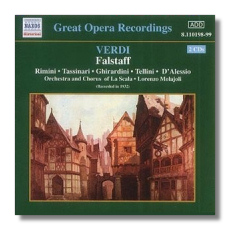
The Internet's Premier Classical Music Source
Related Links
- Verdi Reviews
- Latest Reviews
- More Reviews
-
By Composer
-
Collections
DVD & Blu-ray
Books
Concert Reviews
Articles/Interviews
Software
Audio
Search Amazon
Recommended Links
Site News
 CD Review
CD Review
Giuseppe Verdi

Falstaff
- Giacomo Rimini (Falstaff)
- Pia Tassinari (Alice Ford)
- Emilio Ghirardini (Ford)
- Rita Monticone (Meg Page)
- Aurora Buades (Dame Quickly)
- Ines Alfani Tellini (Nannetta)
- Roberto D'Alessio (Fenton)
- Salvatore Baccaloni (Pistola)
- Giuseppe Nessi (Bardolfo)
- Emilio Venturini (Dr. Cajus)
Orchestra & Chorus of La Scala, Milan/Lorenzo Molajoli
Naxos Historical 8.110198-99 ADD monaural 2CDs: 70:30, 76:05
This was the first commercial recording of Falstaff. As it was made in 1932, it is good to remember that the opera was not even forty years old at the time. (Victor Maurel, the original Falstaff, did record excerpts from his role, but these are in primitive sound and give little idea of what the première night – February 9, 1893 – must have been like.)
Some successful recordings of this opera are assembled around the singer who takes on the title role. Geraint Evans and Dietrich Fischer-Dieskau are the rotund suns around which the rest of the cast rotates, on their respective recordings. (It must be said that their respective conductors, Georg Solti and Leonard Bernstein, leave heavy fingerprints too.) Other successful recordings of Falstaff emphasize a team approach. In 1956, Herbert von Karajan assembled a very balanced cast, with Tito Gobbi in the title role. He doesn't dominate, though, probably because his humor is more sly than pompous; it's as if Figaro had wandered if from another opera. Even earlier, Arturo Toscanini seemed to emphasize his importance even more than Karajan did by selecting a cast that blended well, but that was somewhat lacking in star-power: witness Herva Nelli's lackluster Alice, Frank Guarrera's unfinished Ford, and the unimpressive sound of Giuseppe Valdengo's Falstaff – like Gobbi, but with an even less Falstaffian timbre.
Of these recordings, the present one is most like Toscanini's – no surprise, as Molajoli and Toscanini came from the same tradition. Giuseppe Rimini is remembered even less than Valdengo, and while his interpretation is a little more generalized than any of those mentioned above, the sound of his voice is apt. His Falstaff won't grab you by the collar, but it's a fully satisfactory portrayal. Pretty much the same can be said of all the singers on this recording, although Tassinari's plaintive voice adds expressive highlights to Alice Ford. Buades's Quickly is highly seasoned. (She was a famous Carmen.) For better and worse, this Falstaff is a house wine; it is professional, predictable, and lacking the highest highs and the lowest lows. La Scala boasted a fine ensemble here, and perhaps they didn't want to unbalance it by contracting anyone who would have gravitated to the spotlight more.
Tassinari gets her chance, however, in a thirty-six-minute appendix of arias and scenes from The Marriage of Figaro, Lohengrin (in Italian), Werther (also in Italian), L'Amico Fritz, La Bohème, and Turandot. Like her husband Ferrucio Tagliavini, Tassinari was a good singer to have around, particularly in verissimo roles, and she probably would have been more famous if she hadn't lived in such a bountiful era. Her voice wasn't luxurious, but she was an exemplar of how things were done in the best Italian opera houses at the time.
Ward Marston did the transfers, presumably from the twenty-eight original Italian Columbia shellac sides. Noise and distortion, where present, don't get in the way of the music, but one notices variability in peaking from one side to the next. Naxos' booklet contains a detailed synopsis that is usefully cross-referenced to track numbers.
All in all, this is an important recording of Falstaff because it was the first, and stylistically, it is a useful study document. Most collectors will want something more modern and starry, but the historically-minded will learn a lot from Molajoli and his team.
Copyright © 2002, Raymond Tuttle


















